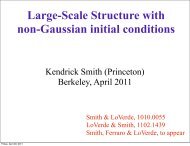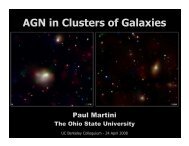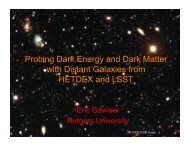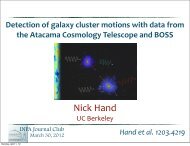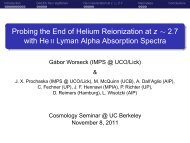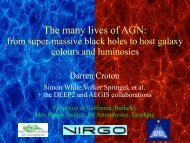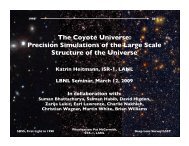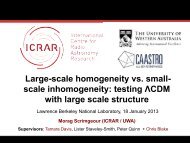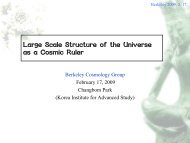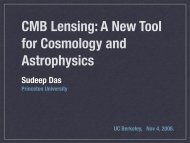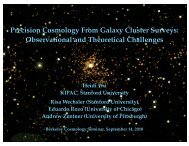The Aquarius Project: Dark Matter under a Numerical Microscope
The Aquarius Project: Dark Matter under a Numerical Microscope
The Aquarius Project: Dark Matter under a Numerical Microscope
Create successful ePaper yourself
Turn your PDF publications into a flip-book with our unique Google optimized e-Paper software.
<strong>The</strong> Structure and Substructure of<br />
Cold <strong>Dark</strong> <strong>Matter</strong> Halos<br />
Julio Navarro<br />
University of Victoria<br />
<strong>The</strong> Virgo Consortium
CDM halos: Main results<br />
• CDM mass profiles are nearly universal<br />
– shape is independent of mass<br />
• CDM density profiles are cuspy<br />
– no evidence for a constant-density central “core”<br />
• CDM halos are clumpy<br />
– Abundant but non-dominant substructure<br />
• CDM halos are triaxial<br />
– Preference for prolate configuration, asphericity<br />
increasing toward the center.
CDM halos: Outstanding issues<br />
• <strong>The</strong> Structure of the Central Cusp<br />
– Power-law divergent slope (ρ ∝r -1 or ρ∝r -1.2 or ρ∝r -1.5 ?)<br />
• Annihilation signal<br />
– Disk galaxy rotation curves (cusp vs core vs triaxiality)<br />
• <strong>The</strong> Structure of Substructure<br />
– Mass profile and abundance of Local Group satellites<br />
– Annihilation signal from substructures and “boost factors”<br />
– Abundance, spatial distribution and kinematics<br />
• lensing flux ratio anomaly, satellite distribution + orbits<br />
• <strong>The</strong> Phase-Space Distribution of <strong>Dark</strong> <strong>Matter</strong><br />
– Implications for direct dark matter detection experiments<br />
• <strong>The</strong> Origin of a Universal Density Profile<br />
– <strong>The</strong>oretical interest<br />
– Important to <strong>under</strong>stand baryon-induced transformations of dark<br />
halo structure
<strong>The</strong> <strong>Aquarius</strong> programme<br />
6 different galaxy size halos simulated at varying resolution, allowing for a<br />
proper assessment of numerical convergence and cosmic variance<br />
<strong>Numerical</strong><br />
resolution<br />
Particle number in<br />
halo (N 50 )<br />
# of substructures mass resolution<br />
Aq-A-4 6,424,399 1,960 3.92 x 10<br />
Aq-A-3 51,391,468 13,854<br />
Aq-A-2 184,243,536 45,024<br />
5 M0 4.91 x 104 M0 1.37 x 104 Aq-A-5 808,479 3.14 x 10<br />
M0 6 299<br />
M0 Aq-A-1 1,473,568,512 297,791 1.71 x 10 3 M 0<br />
(15 pc/h softening)<br />
Springel et al ‘08<br />
“Via Lactea I<br />
simulation” ~10,000 2.18 x 104 84,700,000<br />
M0 “Via Lactea II<br />
simulation”<br />
470,000,000 ~100,000 3.92 x 103 M0 Diemand et al ‘07, 08
Pictures of all <strong>Aquarius</strong> halos (level-2 (level (level-2 2 resolution)<br />
500 500 kpc kpc<br />
Play Movie<br />
<strong>The</strong> <strong>The</strong><br />
<strong>Aquarius</strong><br />
“Billenniu<br />
m” m” halo halo<br />
simulation<br />
. . A dark dark<br />
matter<br />
halo halo with with<br />
1 billion<br />
particles<br />
within the the<br />
virial virial<br />
radius.
500 500 kpc kpc<br />
<strong>Aquarius</strong>: the Billennium simulation<br />
<strong>The</strong> <strong>The</strong> <strong>Aquarius</strong><br />
“Billennium”<br />
halo halo simulation.<br />
A dark dark matter<br />
halo halo with with 1<br />
billion particles<br />
within the the virial virial<br />
radius.<br />
Play Movie
z = 1.5<br />
400 3 run
z = 1.5<br />
1200 3 run
z = 1.5<br />
2400 3 run
z = 0.1<br />
2400 3 run
z = 0.1<br />
2400 3 run
z = 0.1<br />
2400 3 run
<strong>The</strong> Density Profile: numerical convergence<br />
Einasto-Sersic<br />
profile<br />
Scaled Radius
Density*r 2<br />
<strong>The</strong> Mass Profile: numerical convergence<br />
Einasto-Sersic<br />
profile<br />
Radius<br />
r max<br />
V max<br />
•Excellent numerical convergence down to radius where the collisional relaxation<br />
time approaches the age of the universe<br />
Circular Velocity
Density*r 2<br />
Self-similarity in the mass profile?<br />
Scaled Radius<br />
•Slight but significant deviations from similarity.<br />
•A “third parameter” is needed in order to describe accurately the mass profiles<br />
of CDM halos.<br />
Circular Velocity
Velocity structure: convergence<br />
Radius<br />
•Excellent numerical convergence down to radius where the collisional relaxation<br />
time approaches the age of the universe
Velocity structure: self-similarity?<br />
Scaled Radius<br />
•Slight but significant deviations from similarity.<br />
•Note that deviant systems in mass are also deviant in velocity<br />
•Note similarity in shape between density and velocity dispersion
<strong>The</strong> Structure of the Cusp<br />
Radius Scaled Radius<br />
•Logarithmic slope scales like a power-law of radius: the Sersic/Einasto profile<br />
•Innermost profile shallower than r -1
<strong>The</strong> Cusp: Maximum Asymptotic Slope<br />
•Maximum asymptotic slope of the cusp: shallower than r -1
<strong>The</strong> “Phase-Space Density” Profile<br />
r -1.875<br />
Scaled Radius<br />
•Remarkably, the “phase-space density”, ρ/σ 3 , scales like a power law of radius<br />
•This is the same dependence as in Bertschinger’s secondary infall similarity solution<br />
Taylor Taylor<br />
& Navarro Navarro 2001<br />
2001
<strong>The</strong> “Phase-Space Density” Profile<br />
r -1.875<br />
Scaled Radius<br />
•All halos seem to share the same “phase-space density”, ρ/σ 3 , structure<br />
•This seems to reflect a fundamental structural property of CDM halos
A blueprint for detecting halo the CDM<br />
annihilation signal in the Galactic halo<br />
CDM particles may annihilate and lead to production of γrays<br />
which could be observable by GLAST/FERMI<br />
Emission of annihilation radiation depends on:<br />
halo density at x<br />
Springel et et al, al, 2008 2008 Nature (Nov (Nov 8 issue)<br />
∫ ρ 2 (x) ‹σv› dV<br />
cross-section<br />
⇒ <strong>The</strong>oretical expectation requires knowing ρ(x)<br />
⇒ Need accurate high resolution N-body<br />
simulations of halo formation from CDM initial<br />
conditions
Myths about Cold <strong>Dark</strong> <strong>Matter</strong> halo<br />
substructure and annihilation signal<br />
• Halo DM is mostly in small (e.g. Earth mass)<br />
clumps<br />
• Small (Earth-mass) clumps should dominate DM<br />
annihilation signal observable from Earth<br />
• Dwarf spheroidals/luminous satellites are the best<br />
targets for detecting DM annihilation signal<br />
• Halo DM is in a self-similar (fractal) distribution<br />
of nested substructure halos (subhalos)<br />
• Annihilation signal/detectability is significantly<br />
boosted by sub-substructure
<strong>The</strong> mass function<br />
of substructures<br />
<strong>The</strong> subhalo mass<br />
function is shallower<br />
than M 2<br />
• Most of the substructure<br />
mass is in the few most<br />
massive halos<br />
• <strong>The</strong> total mass in<br />
substructures (5-50% of the<br />
total) converges well even for<br />
moderate resolution<br />
dN/dM sub [ M o ]<br />
M sub 2 dN/dMsub [h -1 M o ]<br />
MASS PER LOG INTERVAL<br />
M sub [M o]<br />
N(M) ∝ M α<br />
α = −1.90
<strong>The</strong> substructure circular velocity function<br />
We find 3 times as<br />
many subhalos as<br />
Diemand et al find for<br />
Via Lactea I<br />
• Cosmic variance? - No<br />
• Substructure finding<br />
algorithm? - No<br />
• Different cosmological<br />
parameters? - unlikely<br />
Nevertheless, the<br />
difference in our<br />
conclusions stems from<br />
different assumptions<br />
about visibility of clumps<br />
CUMULATIVE NUMBER OF SUBSTRUCTURES AS A FUNCTION OF VMAX,<br />
N(>V max /V 50 )<br />
VLI<br />
VLII<br />
<strong>The</strong> velocity function of<br />
substructures is close<br />
to a power law
<strong>The</strong> number density<br />
profile of substructure<br />
halos<br />
• <strong>The</strong> spatial distribution of subhalos<br />
(except for the few most massive<br />
ones) is independent of mass<br />
• Most subhalos are at large radii -subhalos<br />
are more effectively<br />
destroyed near the centre<br />
• Most subhalos have completed only<br />
a few orbits; dynamical friction<br />
unimportant below a subhalo mass<br />
threshold<br />
• Subhalos are far from the Sun<br />
n(r)/<br />
df n(
How lumpy is the MW halo?<br />
Mass fraction in subhalos as a function of the free-streaming<br />
cutoff mass in the CDM power spectrum<br />
Σ M sub(>M sub)/M 50<br />
Earth<br />
n = -2<br />
n = -2<br />
n = -1.9<br />
M lim [M 0]<br />
n = -1.9<br />
r < 400 kpc<br />
r < 100 kpc<br />
Substructure mass fraction within R sun < 0.1%
Annihilation radiation from the<br />
Milky Way halo and subhalos<br />
• If small-scale clumping and angular variations in<br />
the background may be neglected, then for systems<br />
with similar density profiles:<br />
1. Luminosity ∝V max 4 /rmax<br />
2. Flux ∝ V max 4 /(rmax /d 2 )<br />
3. Signal-to-noise ∝ V max 4 /(rmax 2 /d)<br />
• <strong>The</strong> known substructure with largest signal-tonoise<br />
is the LMC, but it is easy to show that<br />
– (S/N) MW /(S/N) LMC ~ 134!<br />
• Substructures are easier to detect than the main<br />
halo only if the “boost factor” from small-scale<br />
clumping overwhelms this simple scaling.
A blueprint for detecting halo CDM<br />
annihilation radiation<br />
To calculate L need<br />
contribution from 4<br />
components:<br />
Main halo<br />
subhalo<br />
1. Smooth emission from main halo (MainSmooth)<br />
2. Smooth emission from resolved subhalos (SubSmooth)<br />
3. Emission from unresolved subhalos in main halo (MainUnres)<br />
4. Emission from substructure of subhalos (SubSub)
<strong>The</strong> radiation from the main halo<br />
(MainSmooth)<br />
•Lack of of steep steep<br />
central cusp cusp<br />
means that that the the<br />
radiation from from<br />
the the smooth main main<br />
halo halo component<br />
is is well well defined<br />
and and constrained.<br />
•Half of of the the total total<br />
luminosity comes<br />
from from within<br />
~3kpc, 95% 95% from from<br />
~30kpc<br />
•L~V 4<br />
•L~Vmax 4 /rmax<br />
max /rmax
<strong>The</strong> radiation from<br />
substructures<br />
(SubSmooth)<br />
This depends on being able to<br />
estimate accurately V max and r max for<br />
subhalos<br />
Convergence in the size and maximum<br />
circular velocity for individual subhalos<br />
cross-matched between simulation<br />
pairs.<br />
Largest simulation gives convergent<br />
results for:<br />
V max > 1.5 km/s<br />
r max > 165 pc<br />
Much smaller than the halos inferred<br />
for even the faintest dwarf galaxies
Enclosed mass and annihilation<br />
radiation profiles<br />
MainSmooth<br />
Main halo mass<br />
r half<br />
SubSmooth<br />
> 10 5 M ⊙<br />
> 10 6 M ⊙<br />
> 10 7 M ⊙<br />
> 10 8 M ⊙
<strong>Project</strong>ed annihilation radiation profile<br />
Main halo<br />
Substructures<br />
Extrapolating to<br />
Msub =10-6 Extrapolating to<br />
Msub =10 Msun yields<br />
LSUBSMOOTH ~ 200<br />
-6 Msun yields<br />
LSUBSMOOTH ~ 200<br />
L MAINSMOOTH<br />
MAINSMOOTH<br />
•This is is what would be be<br />
seen by by a distant<br />
observer<br />
•<strong>The</strong> total flux from<br />
SUBSMOOTH and<br />
MAINSMOOTH are are<br />
actually similar for for an an<br />
observer near the the Sun.
Substructures within substructures<br />
<strong>The</strong>re are<br />
substructures<br />
embedded<br />
within other<br />
structures.<br />
We detect 4<br />
generations<br />
of nested<br />
subhalos.<br />
<strong>The</strong> hierarchy<br />
clearly is NOT<br />
self-similar<br />
and is heavily<br />
dependent on<br />
the degree of<br />
tidal stripping<br />
of the subhalo
A “fractal” distribution of nested<br />
substructures?<br />
x
Tidal radius<br />
Tidal effects on sub-substructures<br />
x
Substructures<br />
within substructures<br />
•Cumulative number of<br />
sub-subhalos within<br />
subhalos<br />
• Substructure mass<br />
fraction in subhalos is<br />
lower than in the main halo<br />
Main halo<br />
N(>M sub/M 250)<br />
M sub/M 250
Substructures within substructures<br />
•Sub-substructure abundance in<br />
subhalos is NOT, in general, a scaleddown<br />
version of that in the main halo<br />
because:<br />
Main halo<br />
• substructure abundance reduced by tidal truncation<br />
• sub-subs continue to loose mass through tides<br />
• sub-subs not replenished by infall of fresh halos<br />
subhalo<br />
⇒ Distribution of sub-substructure is NOT self-similar
Emission from substructure within<br />
substructures (SUBSUB)<br />
• Compute tidal radius at<br />
instantaneous position<br />
(conservative!)<br />
•Assume all material beyond r t is<br />
removed<br />
•Scale from main halo (within<br />
scaled r t )<br />
• Correct for luminosity below<br />
(scaled) mass limit<br />
x<br />
Tidal radius
•S/N=F/(θ 2 h +θ2 psf )1/2<br />
S/N for detecting<br />
subhalos in units of<br />
that for detecting the<br />
main halo.<br />
30 highest S/N<br />
objects, assuming<br />
use of optimal filters<br />
Detectability of substructure<br />
SUBSUB SUBSMOOTH<br />
known<br />
satellites<br />
LMC<br />
(S/N)/(S/N) main halo<br />
Highest S/N subhalos have 1% of S/N of main halo<br />
Highest S/N subhalos have 5-10 times S/N of known satellites<br />
Substructure of subhalos has no influence on detectability
Mass and circular velocity of most<br />
detectable substructure<br />
known<br />
satellites<br />
Highest S/N subhalos have masses well below those inferred<br />
for known Milky Way satellites
Distance and angular scale of<br />
most detectable substructures<br />
known<br />
satellites<br />
SUBSMOOTH<br />
SUBSUB<br />
Highest S/N subhalos have half-light radii below 10 arcmin and<br />
will not be resolved by FERMI/GLAST
<strong>The</strong> gamma-ray sky lit by annihilation radiation<br />
MAINSMOOTH
<strong>The</strong> gamma-ray sky lit by annihilation radiation<br />
SUBSMOOTH<br />
+ SUBSUB
<strong>The</strong> gamma-ray sky lit by annihilation radiation<br />
MAINUNRES
<strong>The</strong> gamma-ray sky lit by annihilation radiation<br />
TOTAL
Myths about Cold <strong>Dark</strong> <strong>Matter</strong> halo<br />
substructure and annihilation signal<br />
• Halo DM is mostly in small (e.g. Earth mass) clumps<br />
• Small (Earth-mass) clumps should dominate DM<br />
annihilation signal observable from Earth<br />
• Dwarf spheroidals/luminous satellites are the best<br />
targets for detecting DM annihilation signal<br />
• Halo DM is in a self-similar (fractal) distribution of<br />
nested substructure halos (subhalos)<br />
• Annihilation signal/detectability is significantly<br />
boosted by sub-substructure
ΛCDM on small scales<br />
• Predictions for galactic dark matter in ΛCDM well established<br />
• N-body simulations of ΛCDM predict:<br />
– many small substructures, with convergent mass fraction<br />
– the distribution of DM is not fractal nor is it dominated by<br />
Earth-mass objects<br />
• γ-ray annihilation may be detectable by FERMI which should:<br />
– First detect smooth halo (if background can be subtracted)<br />
– <strong>The</strong>n (perhaps) detect dark subhalos with no stars<br />
– Sub-substructure boost irrelevant for detection
<strong>The</strong> End




